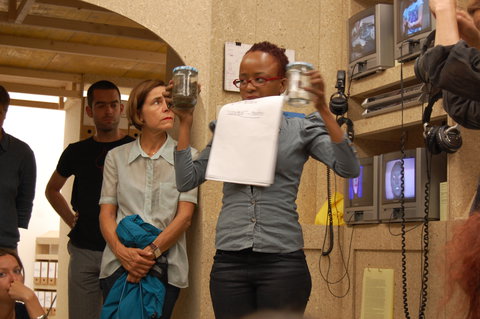
In the practice-oriented research part of our project, archiv performativ: ein Modell, in the Klingental exhibition space, we worked under trial conditions to examine the hypothesis that archives, as guardians of memory, must be actively appropriated and initiate action in order to remain vital. While relying on artefacts to do this, by reactivating them we also created new artefacts. With this practice-led part of the project, we were able to contribute examples of the performative transcription of archive material (of performances given 1998–2006 in Basel’s Kaskadenkondensator). This performative understanding of archive not only draws on the concept of archive formulated by Michel Foucault but also on more recent models of archival art and practice as well as on ideas which archival theory has itself contributed to discourse on the subject. While Foucault sees the archive as a method of constantly restructuring, transforming and constructing knowledge and statements through agents grounded in specific discourses,[1] the art of archiving on the internet works with the concept of ‘re-using’. Online archival projects place the emphasis on accessibility, then, rather than storage.[2] In line with performance theorist and curator Heike Roms, archival theory now stresses that documents only become evidence through the actions of the archivists. These not only administrate but also construct testimonials by means of filing systems, classification and the like.[3] Heike Roms’ oral history project provided an important point of reference for our model archive project.
Working in and on an archive, one must make visible, or bear in mind, the selection procedures and omissions which form the archive.[4] Consequently, the archive can be understood as categorized memory. Wolfgang Ernst puts it like this: “Like every form of memory, it is less a site of historical storage than a site of keeping [memories] at hand, making [them] available and allowing [them] to be updated; hence it is a question of inquiring into the interconnectivity of its functions in a media-archaeological sense rather than the referential illusion we call history.”[5] This is particularly true of archives of performance art, which can only facilitate transmission and transcription through their availability and accessibility. As our survey at the start of the project showed, archives for performance art such as the Franklin Furnace Archive in New York and de Appel in Amsterdam, which have existed since the 1970s, are the exception. No archive for performance art exists in Switzerland, although there are isolated private and semi-private collections and accumulations of documentation material, which artists, organisers and a few institutions hold but do not administrate due to a lack of resources (see Part 1, ‘Findings of the qualitative research’). In this situation, although artefacts of performance art are produced and some of them preserved and stored, they are generally difficult or impossible to access. We would therefore like to propose the creation of a Swiss performance archive, analogous to current efforts on the dance and drama scene, and contribute to it the findings of our research.
[1] Ebeling, Knut / Günzel, Stephan, Theorien des Archivs in Philosophie, Medien und Künsten, Kadmos, Berlin 2009, p. 18.
[2] Cf. Fertig, Julia, „Die Archivfalle“, in kunsttexte. Section Arts, Media, Esthetics, 1/2011, p. 5–6, http://edoc.hu-berlin.de/kunsttexte/2011-1/fertig-julia-3/PDF/fertig.pdf (last accessed 8.6.12).
[3] Roms, Heike, „Eventful Evidence. Historicizing Performance Art“ in MAP – media / archive / performance, 2/2010, perfomap.de.
[4] Cf. Ernst, Wolfgang, „Das Archiv als Gedächtnisort“ in: Ebeling, Knut / Günzel, Stephan, op. cit. fn 3, p. 187.
[5]Translated from the German: „Wie jede Form des Gedächtnisses ist es weniger der Ort der historischen Aufbewahrung denn ein Ort der Bereithaltung, der Zurverfügungstellung und Aktualisierbarkeit; von daher gilt es, medienarchäologisch eher nach der Verkettung seiner Funktionen denn nach seiner referentiellen Illusion namens Geschichte zu fragen,“ in: Ernst, Wolfgang, op. cit. fn 6, p. 186.